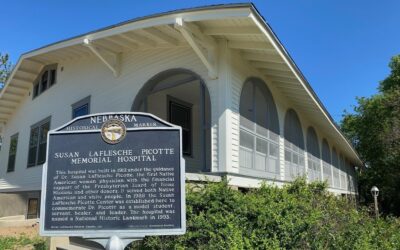The discovery of gold in the Black Hills in 1874 led a number of Nebraska communities, including Kearney, to promote themselves during the next several years as ideal jumping-off points. Kearney in 1877 was being touted as a starting point for the goldfields to the north-the place to which prospectors could travel by train and then disembark to buy their mining supplies before they headed north. The Nebraska State Journal of Lincoln on April 15, 1877, noted a recent visit by Kearney banker C. W. Dake, “manager of the new route to the Black Hills by way of Kearney.”
Dake formed the Kearney and Black Hills stage line in the late winter of 1876 and the early spring of 1877. He was joined in this venture by R. S. Downing, who had moved to Kearney from Lowell in Kearney County. They applied for and were granted the contract to carry mail from Kearney to Deadwood. The route had been laid out the previous summer, and road ranches had been established along the way to provide supplies to travelers. The Journal described the route and Dake’s plans for its development:
“The distance from Kearney to Deadwood is 330 miles, over beautiful rolling prairie most of the way, crossing fine streams well wooded, with any amount of the finest grazing land in the world. The first of May, Mr. Dake informs us, will be put on a line of the Concord coaches, easy and comfortable in every way, and the distance will be made in as short a time as any other line. This route is only 20 miles longer than the route by Sidney [the only Nebraska town to develop a substantial Black Hills trade], and has the advantage to say nothing of any other, of passing over a fine country adapted to agriculture and other like pursuits. Especially will the managers of this line make speed a point to the traveling public, and the large outlay of money in the direction of stock would seem to indicate that they mean business.
“Last Tuesday eighty teams took this route, and got off in good shape, being well provided with all the necessaries of the journey. Among the recent Black Hills outfits going that way was only [one] by J. Nesbit, who took with him a mill and quite a lot of other valuable property. In a short time regular mail service will be commenced on this route, and all the conveniences of modern travel will be introduced. . . .
“It is thought that the distance will be made inside of four days, with proper relays, where food for man and beast can be had. Mr. Dake is making arrangements with certain reliable parties to start eating houses and hotels along the road, and it will not be long before these arrangements will be perfected. After the first of May a tri-weekly line of stages will be run on Tuesdays, Thursdays and Fridays, carrying passengers at figures as low as any.”
The Kearney and Black Hills stage route was used by gold prospectors and freight wagon drivers as well as by stages carrying passengers and mail. It was probably used only during the summer of 1877, because Sidney soon became the accepted jumping-off place from which to leave the railroad and head for the Black Hills.



